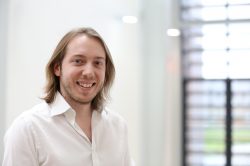06
10
.15
Focus on Research – Dr Ben Bedwell
Research Fellow Dr Ben Bedwell’s work focuses on helping cultural and heritage organisations present the collections and properties they hold. Often, his work involves using new technology to improve visitors’ experience. The unexpected key to his work, however, is his partnering with performance artists, which began before mobile phones became powerful enough to do much more than make a phone call or accept a text message.

“I started about eight years ago working with performance arts groups in cities, working out interesting ways for them to introduce place,” Ben says. Those early walking tours let visitors access information by typing in codes pinned to lamp posts. These codes would unlock text, pictures or a video.
The performance artists opened up another possibility. Visitors thought they were taking a normal walking tour. “In reality, we sent a performer with each person, mostly dancers. They didn’t know about the shadowing, and the shadow would phone them and start talking to them about their surroundings. The visitors all thought it was some sort of magical GPS surveillance system. They loved it, like a personalised tour guide without the hassle of having to chat face-to-face.”
There are some obvious limitations to such a scheme. For one thing, it’s labour-intensive and not scalable to the number of visitors that tourist sites typically need to serve. For another, visitors displayed a lot of implicit trust in the performers, even assuming that they could do anything they weren’t explicitly told was prohibited, such as opening locked doors.
“One issue we had was that people overly trusted the experience they were in, and delegated all responsibility to the person calling them.” Granted, the visitors signed up for the project, but the situation still raises the prospect of ethical issues, both because of the direct trust they placed in the performers and because they didn’t know which bystanders were part of the experience.
“The human contact was compelling,” Ben says, but it was clear that making the service scalable would require both human and technical solutions. Soon afterwards, phones began appearing en masse with GPS and data capabilities so that visitors could go on the Web and find location-relevant information, a vast improvement over the older, expensive bespoke guide systems.
The problems in developing these systems, says Ben, are not necessarily in the technology. In fact, it turned out that in creating a new format for brand new content, he ended up creating a new chore for the organisations he was trying to help. This was a particular issue because many of the organisations he works with are small charities and trusts that already dedicate a lot of time to producing guide books and other materials but that haven’t yet transitioned to digital content. Young people represent a new audience for these organisations – but the requirement for new formats to appeal to this group entails creating a lot of new work.
“The real issue was the digitisation process,” says Ben. “Either they didn’t know how or they didn’t have the resources. That was the sticking point – but they would really benefit from this.”
Currently, Ben is working with the much better-resourced National Trust to study how to use different types of digital information. One realisation is that the Trust routinely collects many kinds of data that it has never imagined might be of interest to visitors but that might open up completely new possibilities for engagement. For example, the Trust conducts biosurveys of the grounds it manages, and keeps records of the plants and wildlife, as well as the properties’ legal boundaries; all the trees are tagged and tracked so the Trust knows when to send people out to treat them. This is all management data – but is also exactly the kind of data people are beginning to work with under the rubric of “open data”. The difficulty is getting started.
“We need a compelling example of how the data could be used,” Ben says. “Visitors are quite interested in the conservation and management processes.” As so often with open data, the stumbling block is the form in which the data is collected and stored: it’s primarily formatted for use in management and by wardens. “They’re learning that they have to be transparent about these things now.” And there are many opportunities to increase the kinds of data that are kept, such as different tree tags.
One of the results of Ben’s work is Wander Anywhere, a Web-based platform that allows anyone to rapidly prototype locative media by associating Web pages with particular geographical points or areas. Users at those locations – such as those in fellow researcher Dr Laura Carletti’s Museo Omero project, or those experiencing Ben’s own Wander Thoresby (see below) – can then access the pages via a tablet or phone’s Web browser. Because Wander Anywhere builds on the WordPress platform, authors are freed from the requirements of developing native mobile applications. The result is that small organisations are able to prototype mobile tourist experiences quickly and cheaply before investing in costly mobile apps.
Wander Thoresby: The Thoresby estate, which occupies several thousand acres in north Nottinghamshire, was the ducal seat of the Earls Manvers, but its historical interest goes beyond a few famous fancy buildings. The public grounds include active forestry land, a working crop, cattle, and sheep farm, and a local government-run environmental education centre. In the past, the estate was also requisitioned by the military for tank training during World War II and contained a colliery. Daily life on the estate from the 1930s to 1970s was recorded in a series of sketches and paintings by Marie-Louise Roosevelt Pierrepont, who married the sixth Earl. Lack of exhibition space means that almost all of her hundreds of artworks (the “Pierrepont Collection”) are archived. The goals of the Wander Thoresby project, therefore, included opening the collection to the public by using new technologies and the grounds and gallery space. An ancillary goal was to make the system easy for staff to update. Users were equipped with a compass and clue booklet, and the gallery contained exhibits that hinted at what experiences they were likely to find.
~Thanks to Wendy Grossman for the compilation of this post~














